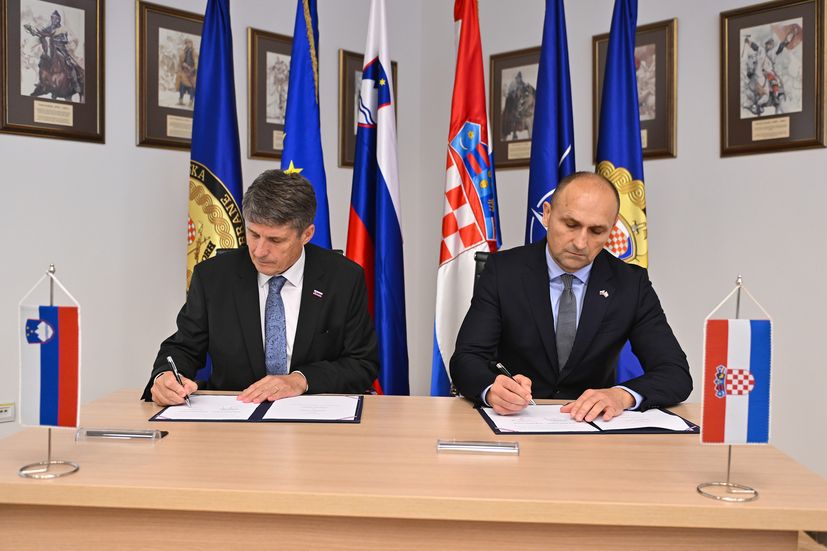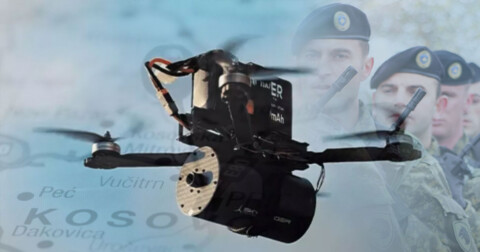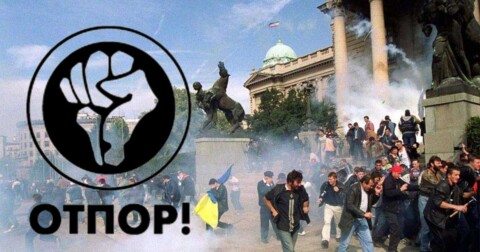Events across the region signal that the time has come to begin a serious reorganization, not only of security policy but also of a thorough reassessment of Serbia’s geopolitical position. Unfortunately, due to the deep internal crisis that has been shaking Serbia for more than two years, Belgrade is seriously lagging behind its neighbors, who are hastily preparing for “something.”
THE MOVE IS GEOPOLITICAL
In recent months, Croatia has signed a series of agreements with Albania, so-called Kosovo, and most recently with Slovenia, concerning military and security cooperation. The fact that the signatories are NATO member states and Serbia’s occupied province — forming, in effect, a ring around Serbia — makes it clear that these moves have little to do with “peace” or “security,” as they are officially framed. Given that these countries openly maintain a hostile stance toward Serbia, these developments are best understood as well-coordinated geopolitical maneuvers aimed not only at isolating Serbia but also at attempting to strategically weaken it and, through so-called passive aggression, force a series of concessions serving Brussels’ interests.
On March 18 this year, the defense ministers of Albania, Croatia, and so-called Kosovo signed in Tirana a “Declaration on Cooperation in the Field of Defense and Security.”
Although officials from the signatory states claimed this was a “political” document without legally binding effect, the reality is that its main signatories, Croatia and Albania, harbor certain territorial ambitions toward Serbia. Furthermore, the declaration represents a manipulative attempt to integrate Serbia’s occupied province into Euro-Atlantic security structures without the consent of the United Nations and in violation of Resolution 1244.
The declaration envisages joint military exercises, cooperation in the defense industry, and — going even deeper into Serbia’s internal security affairs — coordination in intelligence and security matters as well as media and propaganda activities. Considering that so-called Kosovo is not a state, has no international recognition, and certainly none from Serbia, such actions by Croatia and Albania can only be interpreted as a direct hostile provocation on Serbia’s own territory.
Particularly questionable is the timing chosen for signing this declaration…
ALIGNED WITH NATO OBJECTIVES
That this is not the end — but rather just the beginning — is shown by the most recent agreement signed between Croatia and Slovenia. Croatian Defense Minister Ivan Anušić and Slovenian Defense Minister Borut Sajović signed in Zagreb a declaration on cooperation between the two countries’ armed forces, covering “everything that can be done between the two states to make their armed forces and defense industries function better and more efficiently.”
Although the official narratives of the signatories were couched in neutral terms of “good neighborliness,” “regional cooperation,” and “enhancing existing cooperation,” both the structure of the document and the statements of Croatian Defense Minister Anušić point to something else entirely. The declaration openly envisages the integration of defense industries, coordination in procurement, joint work in the field of development and research, as well as aligning security policies with NATO objectives.
In addition, Anušić announced that the next step will be alignment with Bulgaria — essentially a signal of yet another declaration with a NATO country and the formation of a unified regional security front.
Slovenian Minister Sajović stressed that “the world has changed” and that this requires strengthened cooperation not only in defense but also in other areas. He emphasized that Zagreb and Ljubljana bear a “great responsibility” in the Western Balkans, particularly in maintaining peace in Kosovo and Metohija and in Bosnia and Herzegovina.
Croatian and Slovenian officials did not even attempt to hide the fact that this declaration is a continuation of cooperation with Albania and so-called Kosovo, nor that Serbia and Republika Srpska are seen as “disruptive factors” that must be disciplined in order to “maintain peace in the Balkans.”
On this occasion, the Croatian Prime Minister stated that “regional security must not be left to chance, but that it is the obligation of all pro-European forces to act in a coordinated manner.” What does not fall under the category of “pro-European forces” is, of course, Serbia.

GEOPOLITICAL PAWN OR STRIKE FIST?
One of the greatest illusions of the Serbian public is the belief that Croatia represents a dependent member of NATO. The truth, however, is that in recent years Croatia has become an offensive and heavily armed strike fist of the Alliance in the Western Balkans.
Croatia’s accelerated armament began back in 2021, when it announced the purchase of twelve Dassault Rafale multirole fighter aircraft from France. With this step began the most significant modernization of the Air Force in several decades. The first jets arrived in October 2023, and by April 2025 the remainder had been delivered, fully replacing the obsolete MiG-21s that had for decades formed the backbone of Croatia’s fighter aviation.
In November 2024, Croatia signed a contract worth 67 million euros with the Turkish company Baykar Makina, covering the delivery of six Bayraktar TB2 combat drones. Just one day before signing the declaration with Slovenia, Croatia became the first country in the region to possess aircraft of that class. In addition, the deal with Turkey includes a command center, training simulators, control stations, spare parts, and combat munitions.
As part of the American Foreign Military Sales program, which the Pentagon called securing U.S. interests in the Balkans, Croatia received approval for the purchase of eight HIMARS M142 multiple rocket launcher systems, accompanied by 24 guided M30A2 GMLRS rockets and additional equipment, including mobile launchers, a communications system, and GPS receivers. The total value of the contract amounts to approximately 390 million dollars, making this procurement one of the most significant artillery reinforcements.
CREATOR OF GEOSTRATEGIC FLOWS
Croatian media recently reported that procurement is underway for 89 Bradley M2A2 ODS-SA armored fighting vehicles, of which 62 are intended for operational use, five for training, and the rest for spare parts and modernization platforms. Delivery is being carried out in cooperation with the United States, which is also providing technical and logistical support. In addition, the U.S. has supplied Croatia with eight UH-60M Black Hawk helicopters, with Croatia covering only half of the cost, while the rest is compensated by the U.S. on account of Croatia’s donation of 14 Mi-8 helicopters to Ukraine.
Negotiations are also in progress with Germany for the purchase of up to 50 Leopard 2A8 main battle tanks, the latest generation of German armor. At the same time, Croatia has already contracted for the acquisition of the French short-range VL MICA system and the Mistral 3 system, designed for close-range defense against low-flying targets.
In February and March 2025, Croatia’s Ministry of Defense also announced the procurement of a medium-range air defense system from France, though details have not been fully disclosed, as well as CAESAR 155mm self-propelled howitzers, which were delivered by the end of the same year.
Thanks to its partners, who have generously armed it, Croatia has become far more than a loyal pawn — it has evolved into an active creator of geostrategic currents in the Balkans. At the same time, Serbia, consumed by internal chaos — much of it inspired by Croatia — risks being pushed out of the game. The question remains whether it will recognize the tightening encirclement around it and realize just how far behind it already is…
AN ARTERY FOR RAPID NATO FORCE DEPLOYMENT
While Serbia continues to gaze, almost hypnotized, at the southern edge of its territory, believing that Kosovo and Metohija is the only active hotspot worth attention, new fronts are quietly opening on other sides. In this plan, which is already being implemented, the so-called Corridor 7 and the Adriatic–Ionian region are not merely matters of development or economy, but axes of military and political control. Through them, the West — that is, NATO — will, when it deems the time right, be able to deploy troops, equipment, logistics, and influence.
Known also as the Pan-European Transport Corridor, Corridor 7 follows the Danube from Germany to the Black Sea. In theory, under a neutral political framework (which, even in the best of times, has not been favorable to Serbia), it is a trade route. In reality, it is a military highway — the main artery for rapid NATO troop transfers from West to East. In other words, the Danube’s commercial waterway, in any scenario involving a “crisis,” becomes a geostrategic water highway for NATO tanks, boats, drones, and armies.
At the NATO summit in Washington in July 2024, Italy, Albania, Bulgaria, and North Macedonia signed a Letter of Intent to ensure military mobility along this corridor. One need not be an expert to understand the meaning. The very phrase “military mobility” suggests there is no longer talk of “freedom of movement of goods and people,” but of freedom of movement for armored vehicles, missile systems, and uniformed formations that do not ask for permission. In this way, Corridor 7 was officially promoted to a NATO infrastructure priority.
And whoever is not part of this corridor is no longer even in the game. Serbia, though geographically central to the Danube, is not a signatory, not a partner, not even an observer. While Albania, Bulgaria, Croatia, and North Macedonia form a connected NATO line, Serbia is being systematically excluded from the map of all serious security, transport, and supply axes. In the event of escalation, or of that “something” for which all Serbia’s neighbors are hastily preparing, Serbia will remain alone.
That this is not mere speculation is confirmed by the declarations signed between Croatia, Albania, and so-called Kosovo, as well as between Croatia and Slovenia, along with the open invitation to Bulgaria to join their initiative.

SERBIA AS A “DISRUPTIVE FACTOR”
Developments within Serbia, along with the attempt of the Serbian government to maintain a sovereignist policy despite its EU integration agenda — especially concerning Kosovo and Metohija and relations with Russia and China — show that Western “partners” are increasingly viewing Serbia less as a partner and more as an obstacle. In Western security and analytical circles, a narrative has for years been shaped portraying Belgrade as a “disruptive factor,” and Serbia’s neutrality in the war in Ukraine has only reinforced this perception.
While officials in Belgrade speak of “military neutrality” and “balanced relations,” in Brussels, Washington, and Berlin this rhetoric is ever more openly interpreted as a cover for Russia’s strategy. This conviction hardened following the Serbian president’s visit to a military parade in Russia, and was sealed by his visit to China — events that branded Serbia as a threat to European security.
It is also telling that an increasing number of analysts close to Western power centers openly call for the “restructuring” of Serbia. Daniel Serwer, a longtime mouthpiece of the American deep state, commenting on the declaration and Balkan stability, argued that “Serbia is not a factor of peace and stability in the region, because it dominates the security sector in Montenegro, has partners in Republika Srpska, and prevents the integration of Serbs from northern Kosovo into Kosovo’s institutions.”
Nor is Serwer alone. Similar messages are echoed by local pro-European analysts who regularly adopt Western templates in their discourse, frequently invoking the narrative of “malign Russian influence.”
EXPECTATIONS OF WESTERN STRATEGISTS
Western strategists no longer hide their expectations of Serbia: to normalize relations with “neighboring Kosovo,” to join anti-Russian sanctions, to give up on Republika Srpska, and finally to itself accede to the NATO alliance — even if only through informal channels.
Anything else that deviates from these expectations, in the eyes of Brussels and Washington, is branded as “pro-Russian extremism.” In this narrative, Serbia no longer has the right to neutrality, because such neutrality is interpreted by Western “partners” as passive support for the enemy — in other words, there are no neutrals.
Through its regional partners, NATO has already built a ring — political, military, logistical, and media. Croatia, Slovenia, Albania, and so-called Kosovo already act as a single unit, Bulgaria is being invited to join, North Macedonia and Montenegro are already inside, just not yet fully activated. Serbia, not only isolated but also deeply shaken by internal conflicts, is unaware that it has already been squeezed out as an active player on the geopolitical board.
The Serbian state, if it wishes to continue to exist as a subject, must first and foremost understand that there is no longer time for half-measures, and especially not for the policy of “both East and West.” Despite having managed for years to balance skillfully in this field, the moment has come when the ground beneath us is actively shifting, and the platform on which Serbia stands increasingly resembles a minefield rather than a diplomatic stage. This is not due to the abilities of Serbian politicians, but to the sudden turn in Brussels — which, unlike those waging personal battles on the streets of Serbia, clearly recognizes that geopolitical power is shifting with lightning speed, and that this is the last moment to bring Serbian territory under its full control.





